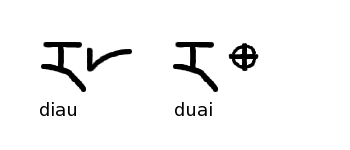Seuna : Chapter 1
Consonants
These are the 17 consonants. All these sounds will be familiar to English speakers apart from "@". The ampersand "@" is used here to represents the glottal stop although some would argue that it would have been better to use the I.P.A. (International Phonetic Alphabet) symbol " ʔ ". The glottal stop is a consonant found in many languages. In English the feature is represented, for example, by the hyphen in uh-oh! and by the apostrophe in Hawaiʻi among those attempting an authentic pronunciation of that name.
The 17 symbols chosen to represent these 17 consonants are more or less copied from Tibetan. These symbols were chosen as it was felt that : although all 17 symbols were very distinct from each other, at the same time they seemed to share a common theme.
There is no correspondence between the phonetic values given here and how they are pronounced in Tibet.
Also there is also no correspondence between how a sound "feels" and how it is written. If there was such a correspondence "s" would be extremely smooth, the nasals would be quite smooth and "k", "p" and "t" would be extremely angular. This does not happen.
There is no scheme that gives these symbols common elements corresponding to common articulation methods. However it can be noted that "b", "p" and "m" have a common element. As do "h" and "@". Also "g" and "y" are quite similar and diachronically "g" => "y" is quite a common sound change.
Vowels
The vowel marks are given below. They are written above the consonants that they follow so for demonstration purposes only, here they are shown over the consonant "d" .
The six diphthongs that are made up of combinations of two of the above simple vowels are shown below.
The two diphthongs that are made up of combinations of three of the simple vowels are shown below.



